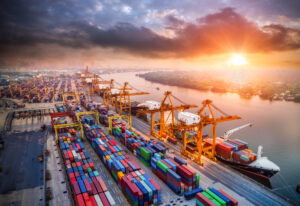The “International Maritime Organization’s [IMO] 83rd Marine Environment Protection Committee (MEPC83) has approved the creation of a new Emission Control Area (ECA) in the North-East Atlantic Ocean. This ECA introduces stricter regulations on emissions from ships, with considerable benefits for both environmental protection and public health. It will be the world’s largest ECA to date,” states an International Council on Clean Transportation (ICCT) press release.
The measures include a new fuel standard for ships and a global pricing mechanism for emissions, setting a minimum fee of $100 per excess ton of greenhouse gas (GHG) emissions above certain thresholds.
This fee is “effectively the first global tax on greenhouse gas emissions,” reports AP News.
“These measures, set to be formally adopted in October 2025 before entry into force in 2027, will become mandatory for large ocean-going ships over 5,000 gross tonnage, which emit 85% of the total CO2 emissions from international shipping,” adds the IMO press release.
The United States left the conference and urged “other countries to do the same and threatening to impose ‘reciprocal measures’ against any fees charged on U.S. ships,” Reuters says.
No other countries are reported to have left the discussions.
“‘The U.S. is just one country, and that one country cannot derail this entire process,’ said Faig Abbasov, shipping director for Transport and Environment, a European advocacy group that has pushed to clean up the maritime industry. The agreement is the ‘first binding decision that will force shipping companies to decarbonize and switch to alternative fuels,’” according to The New York Times.
Objectives
The goal is to achieve the climate targets set out in the 2023 IMO Strategy on the Reduction of GHG Emissions from Ships; accelerate the introduction of zero and near-zero GHG fuels, technologies, and energy sources; and provide support for the transition to these fuels and technologies.
“The thresholds set through the agreement will get stricter over time to try to reach the IMO’s goal of net zero across the industry by about 2050,” adds AP News.
Under the draft regulations, ships will be required to comply with:
- Global fuel standard: Ships must reduce, over time, their annual GHG fuel intensity (GFI)—that is, how much GHG is emitted for each unit of energy used. This is calculated using a well-to-wake approach.
- Global economic measure: Ships emitting above GFI thresholds will have to acquire remedial units to balance their deficit emissions, while those using zero or near-zero GHG technologies will be eligible for financial rewards.
Ensuring compliance
The measures provide for two levels of compliance with GFI targets: a base target and a direct compliance target at which ships would be eligible to earn “surplus units.”
Ships that emit above the set thresholds can balance their emissions deficit by:
- Transferring surplus units from other ships,
- Using surplus units they’ve already banked, or
- Using remedial units acquired through contributions to the IMO Net-Zero Fund.
IMO Net-Zero Fund
The IMO Net-Zero Fund will be established to collect pricing contributions from emissions. Annual fees collected are estimated to be $11 billion to $13 billion.
These revenues will then be disbursed to:
- Reward low-emission ships.
- Support innovation, research, infrastructure, and transition initiatives in developing countries.
- Fund training, technology transfer, and capacity-building to support the IMO GHG Strategy.
- Mitigate negative impacts on vulnerable states, such as Small Island Developing States and Least Developed Countries.
The IMO Net-Zero Framework will be included in a new Chapter 5 of Annex VI (Prevention of air pollution from ships) to the International Convention for the Prevention of Pollution from Ships (MARPOL).
Criticism
While environmentalists support the decision, they say it doesn’t go far enough, according to TIME magazine.
“The fee doesn’t drive enough emission reductions and it won’t raise enough revenue to help developing countries transition to greener shipping, said Emma Fenton, senior director for climate diplomacy at a U.K.-based climate change nonprofit, Opportunity Green,” TIME notes.
“Fenton said the measure actually opens the door for a scenario where ships can pay to pollute instead of decarbonize, because it could be cheaper to simply absorb the fee than to make changes to reduce emissions, like switching fuels.”

